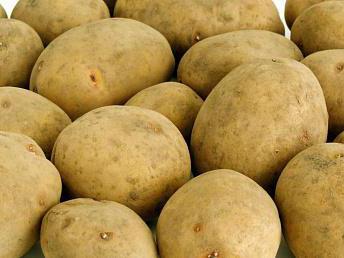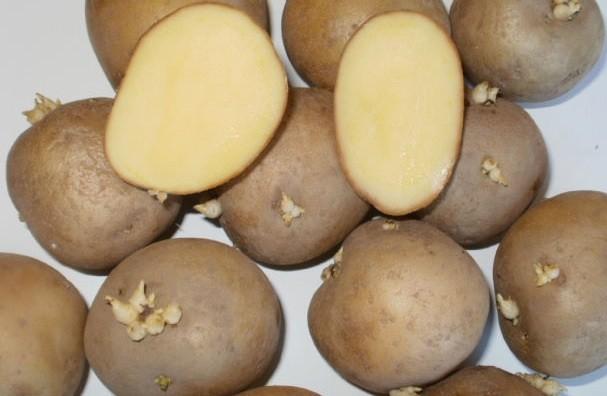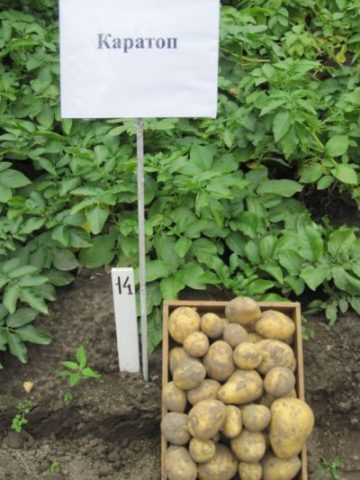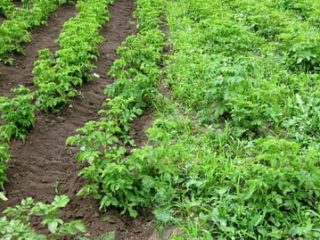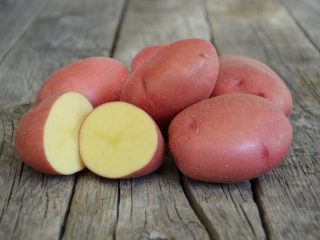Content
Summer residents buy new varieties of potatoes every year and plant them on the site. When choosing a crop, taste, care, yield, as well as resistance to diseases and pests are taken into account. Potato Karatop is an early ripening variety that meets all the characteristics.
Characteristics of Karatop potatoes
Potatoes Karatop - the result of the selection of German scientists. They created the variety in 1998. It was included in the State Register of the Russian Federation in 2000. At first, plants for table variety began to be grown in the North-West and Middle Volga regions. To understand the features of the potato variety Karatop, the photo of which is presented in the article, you need to study the description of bushes and tubers.
Bushes
Plants of medium height, most often with erect shoots and powerful tops. The tops are medium-sized, deep green, intermediate type. The edges of the sheet plates are slightly wavy.
Tubers of the Karatop variety
Small-sized oval-round roots of Karatop potatoes. Their average weight is 60-100 g. As a rule, all tubers in a hole are of different weights. The surface of the fruit is flat, smooth, with a yellowish tinge and slight roughness.
The eyes are shallow, almost on the surface, so peeling potatoes is easy. On the cut, the pulp is light cream or cream. Each tuber contains 10.5-15% starch.
Taste qualities of Karatop potatoes
According to consumer reviews, as well as expert tasters, the root vegetables are very tasty. Taste is estimated at 4.7 points out of 5. Potatoes can be frozen, used for soups, frying, mashed potatoes. Tubers from heat treatment do not darken, they boil well.
Pros and cons of the Karatop potato variety
When creating a variety, German breeders tried to achieve high immunity. They succeeded, because Karatop has a lot of advantages:
- Excellent external data.
- The variety is early ripening, early potatoes can be dug in on the 50th day after germination. Vegetation ends on the 60-65th day.
- The yield of Karatop is high.
- The variety is unpretentious, it can be grown on any soil, although with the addition of mineral fertilizers, the yield increases.
- Universal application of the variety's tubers.
- Potatoes of the Karatop variety are distinguished by excellent transportability.
- The tubers are stored until the new harvest, the yield is at least 97%.
- Root crops are resistant to mechanical damage, cuts overgrow quickly, do not rot.
- Due to its high immunity, Karatop practically does not infect viruses A and Y, potato cancer, nematode, glandular spot.
It is impossible to find cultivated plants without flaws, the Karatop variety also has them:
- the plant does not tolerate drought well, the yield is sharply reduced;
- root vegetables can affect late blight.
Planting and caring for Karatop potatoes
You can plant Karatop potato tubers in the soil after it warms up to a temperature of +9 degrees at a depth of at least 13 cm. Only in this case the planting material will remain alive. The timing will vary in different regions.In areas with a sharply continental climate, work is planned towards the end of May.
Selection and preparation of the landing site
Despite the fact that, according to the description and reviews of gardeners, the potato variety Karatop is unpretentious to the composition of the soil, it is still better to plant root crops in fertile soil. It is better to prepare the site in the fall. Mineral or organic fertilizers, wood ash are applied to the soil and dug up.
Preparation of planting material
Seed tubers should never be planted in the area immediately after they are removed from storage. Potatoes of the variety are taken out a month before the expected planting date and they begin to cook:
- The tubers of Karatop are sorted out, all specimens, even with minor damage and signs of rot, are discarded.
- Then the calibration is carried out. The best planting material is considered to be potatoes the size of a large chicken egg.
- A solution of special preparations is diluted in a cuvette and the tubers are immersed in it for 30 minutes. You can use "Fitosporin" or dilute potassium permanganate.
- After that, the fruits of the Karatop variety are laid out in wooden boxes in 1-3 rows. The room should have a temperature of at least 13 degrees and sufficient lighting.
- During germination, the tubers are turned over so that they are evenly lit. This will ensure better sprouting of the eyes.
- A week before planting, the potatoes are carefully placed in a container of water so that the tubers are saturated with moisture.
- After that, the roots are placed again in the box, covered with foil with holes.
- On the second day, the film is removed and covered with wet sawdust. They are not removed before planting.
By the time of planting, powerful shoots with root rudiments will appear on the tubers of the Karatop variety.
Landing rules
When planting, the roots are buried 22 cm, sprinkled with soil on top. The distance between the holes is about 32 cm, and the row spacing should be 70-82 cm so that the bushes do not interfere with each other during growth. After 10-12 days, the first shoots will appear.
Watering and feeding
Based on the characteristics and reviews of those who grew the Karatop potato variety, the culture responds poorly even to a short-term drought. Therefore, gardeners who decide to take up this plant should take care of the timely watering of the site. It is best to provide overhead irrigation.
The first time the plantings are watered as soon as shoots appear. Then during budding and until the end of flowering.
Loosening and weeding
Any potato plantations, including those with the Karatop variety, must be loosened. This procedure is performed several times to remove a hard crust that does not allow oxygen to reach the tubers. The first loosening is carried out immediately after planting, then the area is harrowed when the first shoots appear.
This procedure will help get rid of small weeds. As the potato bushes grow, so does the grass. It must be removed from the site before hilling. In the future, weeding of the Karatop variety is carried out as the weeds grow. If this is not done, the grass will draw nutrients from the soil, which will negatively affect the yield.
Hilling
Potatoes Karatop, like many varieties of crops, must be spud 2 times. The first time a ridge is made over the bushes at a height of the bush of 20-25 cm. Hilling should be at least 15 cm. The second time the procedure is repeated after 14-21 days, until the tops have closed in rows. You can huddle one plant at a time or rake ridges along the length of a row on both sides.
Diseases and pests
According to the description given by the originators, as well as according to the reviews of gardeners, the Karatop potato variety has high immunity to many diseases, pests and adverse conditions.
Plants practically do not get sick with Y and A viruses, potato cancer, glandular spot and golden nematode. The presence of spores of these diseases in the garden does not reduce the yield of potatoes.
But root crops can suffer from late blight of tubers. To avoid damage, you need to carry out preventive treatments with fungicides, which can be purchased in specialized stores. The solution for spraying plantings is diluted in accordance with the instructions. In addition, to increase the yield and plant immunity, it is recommended to carry out complex baits.
Potato yield
Potato Karatop is a high-yielding early ripening variety. From one hundred square meters, from 500 kg of tasty tubers are harvested. To harvest a decent harvest of early potatoes, you need to take care of timely watering.
Harvesting and storage
The timing of the digging of potatoes depends on the further use of the tubers. If root crops are grown for an early harvest, then the bushes are dug out on the 48-50th day. It should only be understood that the number of tubers will be less than after full ripening.
The main harvest is planned after 60-65 days from the moment the first shoots appear. The bushes are undermined with a shovel or pitchfork, raising the soil. Then the roots are selected. The potatoes are laid out in the sun for 2-3 hours to dry. Then the roots are harvested for 2-3 weeks in a dark, well-ventilated room for further ripening.
Before harvesting for winter storage, the tubers are sorted out, sorted by size. Small potatoes are not left for long-term storage, they must be used immediately. Tubers are stored in the basement, in boxes or in bulk. Experienced gardeners recommend pollinating each row of potatoes with wood ash.
Conclusion
Karatop potatoes were recommended for cultivation in only two regions. Today, the geography has expanded significantly, since many consumers liked the roots.
To learn more about the recommendations for growing early potatoes, see the video below:
